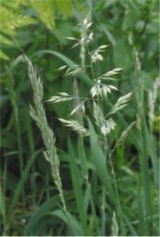
Creeping Soft Grass
Encyclopedia

Poaceae
The Poaceae is a large and nearly ubiquitous family of flowering plants. Members of this family are commonly called grasses, although the term "grass" is also applied to plants that are not in the Poaceae lineage, including the rushes and sedges...
, native to Europe
Europe
Europe is, by convention, one of the world's seven continents. Comprising the westernmost peninsula of Eurasia, Europe is generally 'divided' from Asia to its east by the watershed divides of the Ural and Caucasus Mountains, the Ural River, the Caspian and Black Seas, and the waterways connecting...
and western Asia
Asia
Asia is the world's largest and most populous continent, located primarily in the eastern and northern hemispheres. It covers 8.7% of the Earth's total surface area and with approximately 3.879 billion people, it hosts 60% of the world's current human population...
.
Characteristics
Holcus mollis is a rhizomatousRhizome
In botany and dendrology, a rhizome is a characteristically horizontal stem of a plant that is usually found underground, often sending out roots and shoots from its nodes...
perennial grass found in woods and hedgerows, growing to 50 cm tall. It has rhizomes that occur around 5 cm deep in soil or sometimes deeper. Rhizome growth occurs in the period May to November but is fastest from mid-June to mid-July. The rhizomes have many dormant buds that do not develop unless the rhizomes are disturbed and then fresh aerial shoots may arise from the broken fragments. It flowers from June to July.
The main distinguishing characteristics from H. lanatus are the presence of rhizomes, and the bearded nodes or 'hairy knees' on the culm
Culm
Culm, in botanical context, originally referred to a stem of any type of plant. It is derived from the Latin word for 'stalk' and now specifically refers to the above-ground or aerial stems of grasses and sedges....
.
Habitat preference
Holcus mollis is favoured by conditions in woodland clearings and at the early stages of coppicing. Growth and flowering are restricted as the tree canopy develops. It is often a relict of former woodland vegetation, surviving in open grassland and grassy heaths after woodland clearance despite being a shade lover. It is found mostly on moist, freely-drained acid soils, normally light to medium texture and high in organic matter; it is absent from areas of calcareous or base rich soil, and often grows with brackenBracken
Bracken are several species of large, coarse ferns of the genus Pteridium. Ferns are vascular plants that have alternating generations, large plants that produce spores and small plants that produce sex cells . Brackens are in the family Dennstaedtiaceae, which are noted for their large, highly...
.
Insect foodplant
The caterpillarCaterpillar
Caterpillars are the larval form of members of the order Lepidoptera . They are mostly herbivorous in food habit, although some species are insectivorous. Caterpillars are voracious feeders and many of them are considered to be pests in agriculture...
s of some Lepidoptera
Lepidoptera
Lepidoptera is a large order of insects that includes moths and butterflies . It is one of the most widespread and widely recognizable insect orders in the world, encompassing moths and the three superfamilies of butterflies, skipper butterflies, and moth-butterflies...
use it as a foodplant, e.g. the Essex Skipper
Essex Skipper
The Essex Skipper is a butterfly of the Hesperiidae family. In North America, it is known as the European Skipper....
(Thymelicus lineola).
Status as a weed
In a survey of weeds in conventional cereals in central southern EnglandEngland
England is a country that is part of the United Kingdom. It shares land borders with Scotland to the north and Wales to the west; the Irish Sea is to the north west, the Celtic Sea to the south west, with the North Sea to the east and the English Channel to the south separating it from continental...
in 1982, it was found in 1% of winter barley but not at all in winter wheat or spring barley.
Each small piece of rhizome is capable of developing into a new plant. Research shows that within 6 - 8 inches of the surface, a square foot of rhizome infested soil may contain up to 110 feet (33.5 m) of rhizome, the weight of roots and rhizomes being estimated at 7.5 tons per acre.
Varieties and hybridisation
A pentaploid variant of Creeping Soft Grass is common in Britain, it is sterile but spreads vegetatively. Var. H. mollis variegatus has striped green and white leaves; it is sometimes cultivated.A male sterile hybrid with Holcus lanatus exists with 2n = 21 chromosomes. Hybrids tend to resemble H. lanatus in their morphology.

